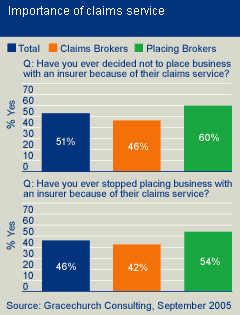Client service - the changing dynamics
In the wake of the Spitzer inquiry, many clients and industry parties have highlighted the need for, and potential benefits of, increased transparency and accountability in the placement of insurance through brokers. It is important that we fully understand and are able to respond to the changing requirements of our clients.
We have therefore conducted several research projects during 2005 and have been involved in research carried out by Lloyd's on behalf of the market.
A wide-ranging customer satisfaction survey commissioned by Lloyd's in 2005 provides a useful benchmark against which to measure service improvements to date and future priorities. Telephone interviews were conducted with over 400 brokers, coverholders, insureds and reinsureds in the UK and US across a broad range of business classes. The majority of respondents agreed that business processing had improved at Lloyd's in recent years. Three areas of concern remain: speed of policy issuance, provision of information through the claims process and speed of settlement.
Question: To what extent have the processes covered in this survey improved on the whole in recent years?
 |
|
We also participated in a further broker survey conducted by Gracechurch Consulting which focused on claims service. 100 claims brokers were interviewed on the service performance of 25 Lloyd's and London market insurers.
Amlin's claims service was ranked first of the 25, with particular out-performance in effective technology, establishing good relationships, and the availability and expertise of claims staff. Client to peer endorsement is of course the acid test of service delivery and is an important differentiator in a crowded market. Amlin gained the highest level of recommendations among the companies surveyed.
The survey also indicated that brokers are measuring more service factors more regularly than before. Moreover they are increasingly penalising poor claims service by not placing business with, or discontinuing use of, a particular insurer as a result.
Finally, we commissioned an in-depth qualitative analysis of the selection criteria used by UK regional brokers. We used independent consultants to interview over 30 brokers, some of whom were Amlin clients and all of whom specialise in commercial insurance. We sought their views on distribution flows, the drivers of buying behaviours and the potential of IT to improve service levels. This suggested that there is encouraging potential for growth arising from our approach to business and investment in technology.
Increased transparency
Increased transparency around the roles of brokers and risk carriers at each stage of the risk placement process is leading to a better appreciation of the roles of each. During the second half of 2005 we interviewed the lead underwriters of 20 classes of business which provided 84% of our 2005 premiums. We examined both the dynamics and practicalities of the underwriter/broker relationship and how these might change over the next few years.
The 'Box' at Lloyd's is the main interface with customers, and key stages of the process (negotiation and agreement of terms) are generally performed there. Several areas were identified where we may improve our service to Lloyd's brokers including more effective management of the renewal process and provision of follow up quotations on new business to improve conversion rates. Certain areas where a more targeted marketing approach would be beneficial in influencing key decision makers in the placement process were also identified.
During the first half of 2006 this work will be extended to interviews with key London brokers on a class of business basis. |